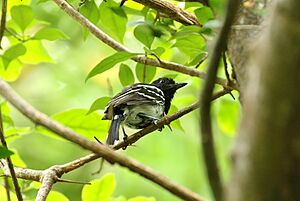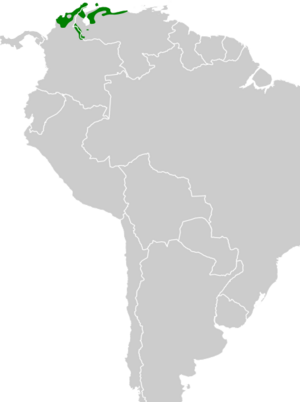Black-backed antshrike facts for kids
Quick facts for kids Black-backed antshrike |
|
|---|---|
 |
|
| A black-backed antshrike in Colombia on 13 January 2019 | |
| Conservation status | |
| Scientific classification | |
| Genus: |
Thamnophilus
|
| Species: |
melanonotus
|
 |
|
| Synonyms | |
|
Sakesphorus melanonotus |
|
The black-backed antshrike (Thamnophilus melanonotus) is a cool type of bird found in Colombia and Venezuela. It belongs to a group of birds called "typical antbirds."
Contents
How Scientists Classify It
Scientists like to group living things to understand them better. The black-backed antshrike was first described by an English zoologist named Philip Sclater in 1855. He gave it the scientific name Thamnophilus melanonotus.
For a while, this bird was placed in a different group called Sakesphorus. But in 2007, a special study looked at the birds' DNA. This study showed that the black-backed antshrike actually fit better with its original group, Thamnophilus. So, it was moved back! This bird is considered "monotypic," which means it's the only species in its group.
What Does It Look Like?
The black-backed antshrike is about 15 to 16 cm (6 to 6.3 inches) long. Birds in the Thamnophilus group are fairly large for antbirds. They all have strong bills with a hook, a bit like a shrike's bill.
- Male Birds: Adult males have a black or very dark brown head and back. They have white edges on their shoulder feathers and a hidden white patch between them. Their lower back and rump are light gray. Their wings are black with wide white tips and white edges on the flight feathers. Their tail is black with white tips and edges. Their throat and chest are black, while their sides, belly, and under-tail feathers are white.
- Female Birds: Adult females have a dark brown crown (top of the head) with cinnamon-colored edges on the feathers. Their face is a light yellowish-brown. Their upper body is brown with darker centers on the feathers. Their wings are brownish-black with pale yellowish-brown edges and tips. Their tail is reddish-brown with whitish tips and edges. Their underparts are yellowish-brown, becoming whiter on the belly.
- Young Males: Younger males look a lot like adult females, but they start to show some black feathers as they grow.
Where Does It Live?
The black-backed antshrike lives in two separate areas. One population is found along the Caribbean coast from northern Colombia, stretching east into northwestern Venezuela. The other population lives in the Zulia River valley in Colombia and the nearby mountains in western Venezuela.
These birds like to live in the lower and middle parts of dry forests, especially where there are lots of thick vines. You can find them from sea level up to about 1,000 meters (3,300 feet) high in Colombia. In Venezuela, they can be found up to 1,300 meters (4,300 feet), but they usually stay below 500 meters (1,600 feet).
How It Behaves
Moving Around
Scientists believe the black-backed antshrike stays in the same area all year long. It doesn't seem to migrate.
What's on the Menu?
The black-backed antshrike mainly eats insects. It probably also eats other small arthropods (like spiders). It's a bit slow when it hunts for food. It usually forages alone or with one other bird. It rarely joins large groups of different bird species looking for food.
It mostly searches for food on or near the ground, up to about 6 meters (20 feet) high. It especially likes to look for food in tangled vines. It finds food by picking it off leaves and branches, making short jumps upwards, or pouncing onto the ground. Sometimes, it even follows swarms of army ants to catch insects that are trying to escape the ants.
Starting a Family
In northern Colombia, the black-backed antshrike breeds between March and July. We don't know much about its breeding season in Venezuela. Only one nest has ever been found. It was an open cup-shaped nest hanging in a tree branch. It held two eggs. We don't know how long it takes for the eggs to hatch or for the young birds to leave the nest. We also don't know much about how the parents care for their chicks.
What Sounds Does It Make?
The black-backed antshrike seems to have two main songs. One is a soft "cuua." The other is a short, nasal rolling sound, "qurrrrrr." It also makes other sounds, like a short nasal "caaa-aa," a nasal grunting "gur'r'a," and a soft nasal "ca-hunk?"
Is It Safe?
The IUCN (International Union for Conservation of Nature) has looked at the black-backed antshrike and says it's of "Least Concern." This means it's not currently in danger of disappearing. It lives across a large area. We don't know exactly how many of these birds there are, but their numbers seem to be decreasing.
No immediate big threats have been found. It's considered uncommon in Colombia and uncommon and local in Venezuela. It lives in one protected area in Venezuela. However, a potential threat is that much of the dry forests where it lives are being turned into farms, especially for goats. This is something that needs to be watched carefully.
Images for kids



